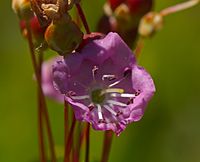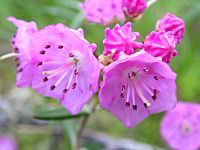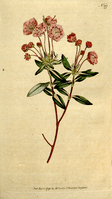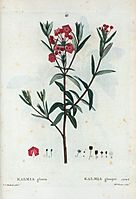Kalmia polifolia facts for kids
Quick facts for kids Kalmia polifolia |
|
|---|---|
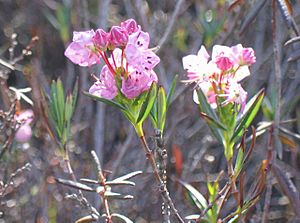 |
|
| Scientific classification | |
| Genus: |
Kalmia
|
| Species: |
polifolia
|
| Synonyms Chamaedaphne glauca |
|
|
Kalmia glauca |
|
The Kalmia polifolia, also known as bog laurel or swamp laurel, is a type of shrub. It stays green all year round. This plant grows in cold, wet, and acidic areas called bogs. It belongs to the plant family Ericaceae. You can find it in north-eastern North America, from Newfoundland all the way south to Hudson Bay.
Contents
What's in a Name?
The name 'Kalmia' comes from Pehr Kalm. He was a Swedish-Finn botanist who studied plants. He was also a student of Linnaeus, a famous scientist.
The name 'polifolia' is a Latin word. It means 'pole-leaves' or 'pole-petals'.
The plant's old name, 'glauca', is also Latin. It means 'gleaming' or 'gray'. This word comes from the Ancient Greek word 'γλαυκός', which means blue-green or blue-gray.
History of the Plant
A German botanist named Friedrich Adam Julius von Wangenheim was the first person to describe this plant.
Where It Grows
Kalmia polifolia is very common in Northern North America. It grows well in the eastern states of America and in Montana. You can also find it in almost every part of Canada. It is especially common in eastern Nova Scotia, where there are many bogs. This plant has even been seen in a bog in Surrey, England.
What It Looks Like
Kalmia polifolia starts to flower in April. Bees help to pollinate its flowers. But be careful, the honey made by bees from this plant can be poisonous! The plant's seeds are ready in September. They are round, woody, and have five parts.
This shrub can grow up to two feet (about 60 cm) tall. Its leaves grow opposite each other on the branch. They are about one to one and a half inches (2.5 to 3.8 cm) long. The leaves often feel waxy.
The flowers grow in a bunch at the end of the stem. They are usually pink or purple. Each flower looks like a small cup and is about three-eighths of an inch (about 1 cm) wide.
Uses of Bog Laurel
As Medicine
People have used Kalmia polifolia on the skin for wounds or swelling. It has also been used for problems like bleeding or diarrhea. However, it's important to remember that this plant is very poisonous.
As Poison
Every part of the Kalmia polifolia plant is very poisonous to animals and people. It contains a substance called grayanotoxin. If eaten, this can make blood pressure drop. It can also cause problems with breathing, dizziness, throwing up, or diarrhea.
Other substances in the plant, like andromedotoxin, can make your heart beat slower. They can also lower blood pressure and cause paralysis.
Animals like cattle, goats, and sheep have been poisoned by this plant. If a goat eats enough of it, they might feel sad, sick to their stomach, drool, throw up, or grind their teeth. Sheep might also feel sad, stagger, feel sick, lie down, drool, and throw up.
As Food for Animals
Caribou are animals that can eat many different plants. They often eat Kalmia polifolia in the spring and summer. This plant can make up a small part of their diet.
For Gardens
Kalmia polifolia has been planted in the Montreal's First Nation Garden. This garden has over 300 different kinds of plants.
Gallery
-
Kalmia glauca, by Pierre-Joseph Redouté (1759-1840)
-
Kalmia polifolia, by Mary Vaux Walcott (1860-1940)
See also
 In Spanish: Kalmia polifolia para niños
In Spanish: Kalmia polifolia para niños




